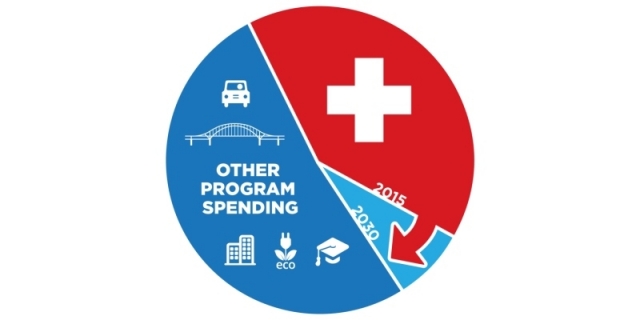Health care spending could consume almost 50 per cent of provincial budgets by 2030
Provincial government spending on health care is projected to increase significantly over the next two decades triggering higher taxes, larger deficits, and/or reduced spending on other services, finds a new study released today by the Fraser Institute, an independent, non-partisan Canadian public policy think-tank.
The study, The Sustainability of Health Care Spending in Canada, finds that, in every province, health care spending is expected to consume an increasing portion of total provincial government program spending – growing to an average of 47.6 per cent in 2030 from 40.6 per cent in 2015 and 34.4 per cent in 1998.
“Given historical trends, expectations regarding inflation in the future, and an aging population, the status quo on health care spending is not sustainable,” said Bacchus Barua, study co-author and senior economist at the Fraser Institute’s Centre for Health Policy Studies.
In Canada, provincial governments shoulder significant financial responsibility for funding health care services along with other public programs such as education and social services. Of these, health care is, by far, the single largest item in their budgets.
In 2015, Nova Scotia had the highest ratio of provincial health spending as a percentage of program spending (44.6 per cent), followed by Ontario (42.9 per cent) and British Columbia (42.7 per cent).
The study estimates that by 2030, five provinces (PEI, Nova Scotia, New Brunswick, Ontario and British Columbia) will see health spending grow close to or exceed 50 per cent of total program spending.
“The rate of increase expected in health care spending is clearly unsustainable. If governments continue down this path, it will necessitate changes in other poli-cies — either reductions in other spending to accommodate the increases in health care spending, or higher taxation, higher deficits and debt, or some combination of these three,” Barua said.
Only Saskatchewan, Quebec, and Newfoundland & Labrador are expected to be successful in constraining the growth in health care spending.
“Changes are clearly needed in Canada’s health care system in order to ensure the sustainability of not only health care, but also other priority areas of spending,” concluded Barua.
Provincial Health Spending as Percentage of Total Program Spending:
BC 42.7% -2015 52.6%- 2030
Alberta 42% – 2015 47% – 2030
Saskatchewan 37.5% – 2015 39.1% – 20130
Manitoba 41.1 – 2015 45.3% – 2030
Ontario 42.9% – 2015 49.5% – 2030
Quebec 34.5% – 2015 36.6% – 2030
Canada 40.6% -2015 47.6% – 2030

























